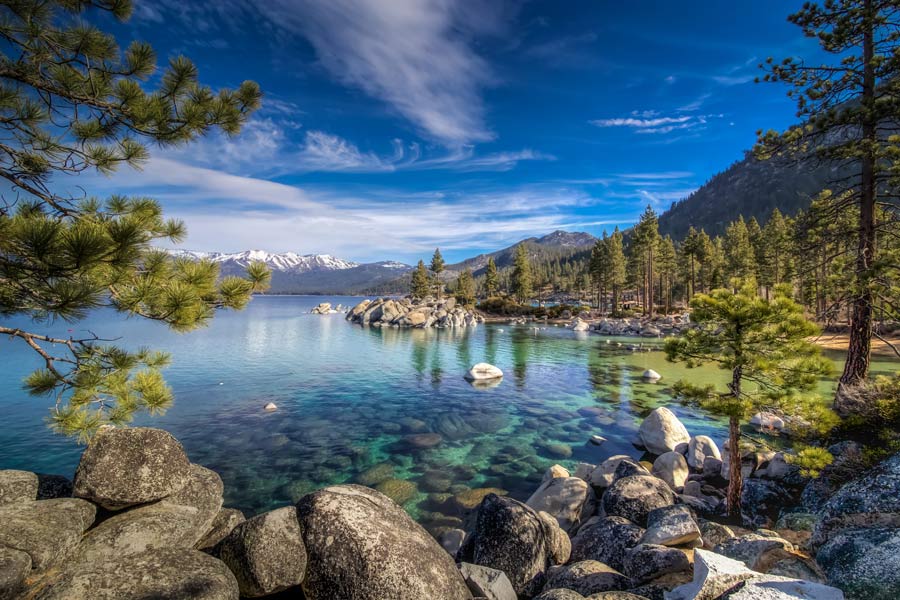Flipping out: Lake Tahoe fully mixes for first time since 2018-19

Provided/Hannah Pence
INCLINE VILLAGE, Nev. — It might not look like it but Lake Tahoe is going through some changes. The lake is flipping for the first time since the winter of 2018-19.
What does that mean? It means it fully mixed vertically from top to bottom.
The full mixing started on Feb. 27 or 28 and while it’s an annual event in shallower lakes, with Tahoe’s 1,640-foot depth, it’s a less common occurrence.
How do we know it flipped? UC Davis Tahoe Environmental Research Center researchers are on the lake every week sampling the water quality, the phytoplankton, and the overall health. Researchers also maintain instruments in the lake, which take measurements every few minutes.
Typically mixing starts in the fall, with the surface layer of the lake cooling and gradually mixing deeper. Most years, the mixing does not extend beyond 1,000 feet. On Feb. 1, the lake had only mixed to 500 feet. In less than four weeks, it had mixed a further 1,100 feet. On March 3, the entire lake was essentially the same temperature from top to bottom.

Provided / TERC
The bottom temperature of the lake is a steady 41.34 degrees. A buoy on the lake surface measured a temperature of about 42.1 on Feb. 10. While it wasn’t a straight decline in temperatures, the surface of the lake slowly cooled until it reached an equal temperature with the bottom on Feb. 28.

Provided / TERC
In March, researchers will retrieve an instrument deployed at the lake’s bottom near Glenbrook and will have a minute-by-minute description of events at the bottom during mixing.
“It’s not as dynamic or turbulent as we might think,” said the Dr. Geoffrey Schladow, director/professor of civil and environmental engineering for TERC. “It happens very slowly … it’s taking hours for this thing to mix top to bottom, so it’s not like a blender.”
What causes the mixing? Surprisingly, the air temperature is the largest factor, not the intensity of individual storms. This has been a particularly cold winter, causing the lake to mix deeper and weeks earlier compared to most other years.
Is deep mixing good or bad? It is extremely good for the lake as it renews the water at the lake bottom with “fresh” oxygen-rich water from the surface. Oxygen is constantly being lost from the lake bottom, so it requires replenishment. Mixing also helps cool the bottom of the lake, which slowly warms due to geothermal heating.
Are there any other impacts? The deepest waters of the lake are also the clearest waters, so when they are mixed with the overlying water there is a short period of high clarity. This year, two days after mixing, the Secchi depth was an astounding 115 feet, almost 33 feet deeper than it had been a week earlier.
However, the length of time that higher clarity will last is a little unclear.
“It depends how long the whole mixing event lasts. Sometimes, in the past, it’s literally just been mixing for a few days, sometimes it’s been as long as two or three weeks,” Schladow said. “So the longer it lasts, the longer cooling lasts.”
Schladow went on to say that this year may be an outlier. It started earlier than usual (they usually start at the end of March) and the cold temperatures are forecasted to last a while, so it could be a longer mixing period.
The mixing also redistributes nutrients. Algae and organic material in the lake eventually ends up at the bottom, and through decomposition nutrients are released. These nutrients can build up over many years, so when deep mixing takes place, the bottom nutrients are carried all throughout the lake. In some years this is the largest source of nutrients to the lake surface and can lead to increased algal growth as well as a decline in lake clarity. In the coming months, we expect clarity to decrease as algae grow and fine particles begin entering the lake with the snowmelt.
There are still a lot of unknowns on how this will impact the summer. High inflow from snowmelt in streams usually causes lower clarity. So, Schladow and his team are excited to study this lake this summer and be able to explain how each factor impacted lake conditions.
TERC gave a shout out to the field team who are out in all seasons collecting measurements and deploying instruments in all kinds of weather, and to the data impresario Dr. Shohei Watanabe who waits eagerly for each piece of new data. The temperature data collection was in part funded by the Tahoe Regional Planning Agency. The temperature buoys are operated in collaboration with the NASA Jet Propulsion Laboratory.
TERC contributed to this article.

Support Local Journalism

Support Local Journalism
Readers around the Lake Tahoe Basin and beyond make the Tahoe Tribune's work possible. Your financial contribution supports our efforts to deliver quality, locally relevant journalism.
Now more than ever, your support is critical to help us keep our community informed about the evolving coronavirus pandemic and the impact it is having locally. Every contribution, however large or small, will make a difference.
Your donation will help us continue to cover COVID-19 and our other vital local news.











